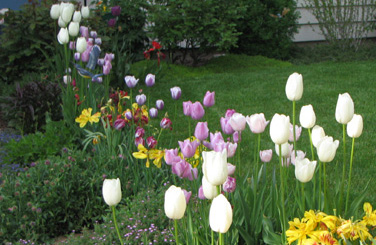Bulbs
Many spring flowering bulbs grow actively when natural spring rainfalls keep soils moist. They stop active growth and go dormant in the summer when soils dry down. Most of these bulbs can be used in water-conserving landscapes. Species native to dry regions of the world can be used in even the driest parts of the garden.
Scientific name |
Common name |
| Allium cernuum | Nodding onion |
| Anemone blanda ● | Grecian windflower |
| Camassia spp. | Camas |
| Chionodoxa spp. @ | Glory-of-the-snow |
| Crocus spp. |
Crocus |
| Fritillaria imperialis ● | Crown imperial |
| Galanthus nivalis ● | Common snowdrop |
| Hyacinthus orientalis | Hyacinth |
| Iris reticulata | Netted iris |
| Lilium spp. | Lily |
| Muscari spp. | Grape hyacinth |
| Narcissus spp. | Daffodil |
| Scilla spp. ●@ | Squill |
| Tulipa spp. | Tulip |
| Tulipa batalinii | Species tulip |
Page navigation
Scientific and common names are listed for each plant. Plants are listed in alphabetical order by scientific name.
If the scientific name has a link, it leads to a page with photos and cultural information. If the common name has a link, it leads to photos, but not to cultural information.
Key to symbols
spp. = More than one species is water-conserving
● = Suitable for dry shade; amount of shade varies
N = Native to Washington or Idaho
@ = May reseed or spread
Life is good at WSU.
Secondary content can be almost anything. If you are not using this region delete all the content that is in between the div tags with the id ="additional".
A unique richness of students, faculty, location, activities, and organizations creates a full, lively student life at the University. This section gives you the insider's view on student life and a sampling of the opportunities here.
"Glimpses." Students talk about life at WSU
These brief posts are written by WSU students to give you a personal look through their window on campus life.
